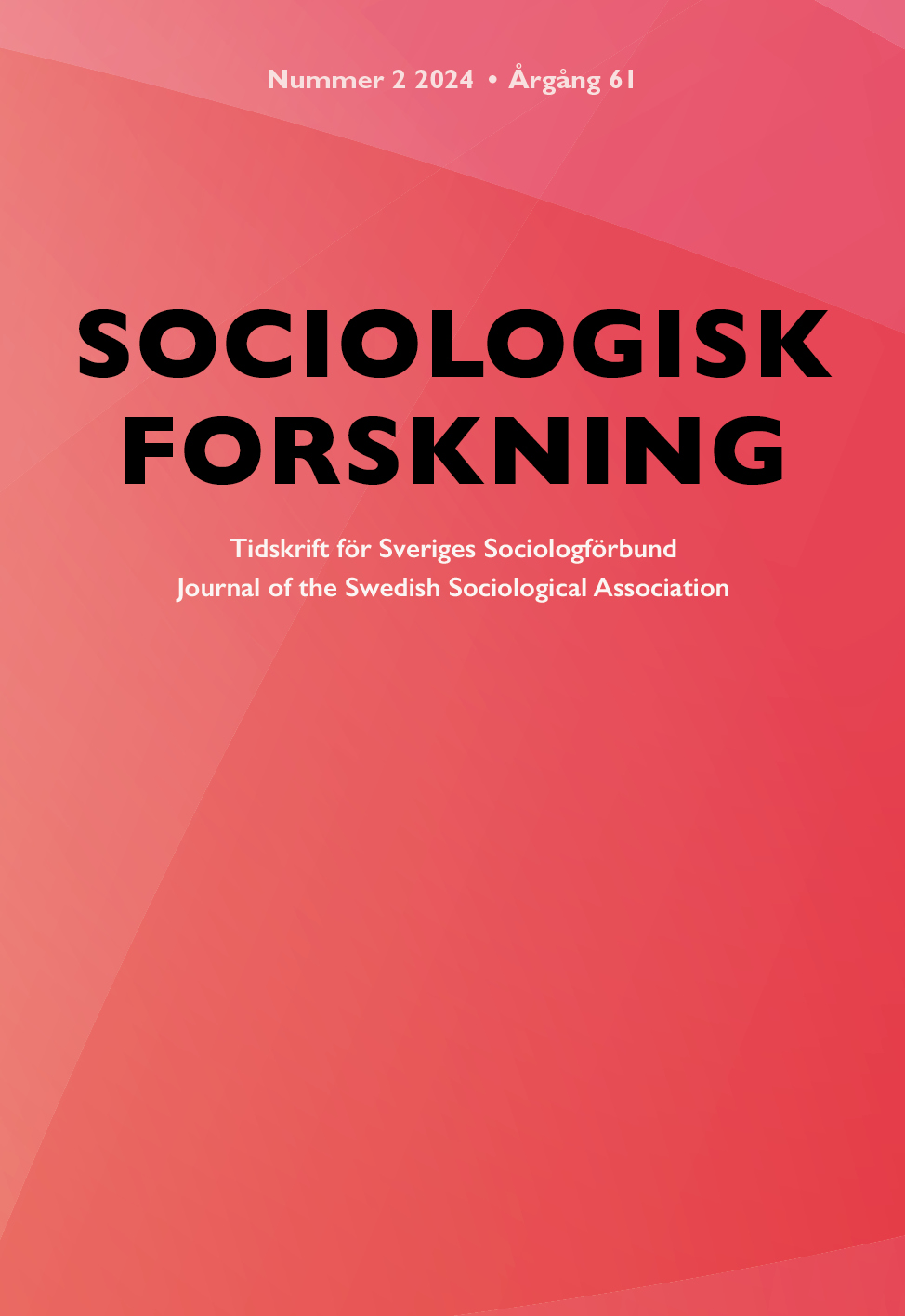“Every hour in the pool counts”
A temporal-spatial perspective on physical education teachers’ experiences of swimming lessons in Swedish primary schools
DOI:
https://doi.org/10.37062/sf.61.25798Keywords:
swimming ability, swimming teaching, time geography, power-geometry, racializationAbstract
In Sweden, in order to obtain a grade in physical education, a primary school pupil must demonstrate swimming ability to their teacher - which is defined as being able to swim 200 meters (including 50 meters backstroke). According to the law, the school must also conduct swimming lessons. In a qualitative survey study with 111 teachers in primary schools across the country, a clear inequality emerges regarding their prerequisites for conducting swimming lessons. A time-geographical perspective illustrates how swimming lessons are a unique type of teaching project that tends to require more time, resources, and coordination than other school subjects. Pupils with a non-Euro-American background and a poorer socio-economic background seem to be overrepresented when it comes to the need for school swimming lessons. The uneven distribution of such students between schools, geographical distance to the nearest pool, or the pool’s capacity affects the conditions as well as the school’s (and the municipality’s) financial priorities and/or resources. These factors constitute different types of capacity, coupling and control restrictions in the allocation of teaching time.
References
Andersson, A. (2016) Den koloniala simskolan. Göteborg: Glänta Produktion.
Becker, G. (1965) ”A theory of the allocation of time”, The Economic Journal 75 (299):493–517.
Betygsutredningen (2020) Bygga, bedöma, betygssätta. Betyg som bättre motsvarar elevernas kunskaper – Betänkande av Betygsutredningen 2018. SOU 2020:43. Stockholm: Fritzes offentliga publikationer.
Björck, H. (2008) Folkhemsbyggare. Stockholm: Atlantis.
Björklund, J. & N. Sabuni (2009) ”Slut med befrielse från skolans sexundervisning”, Dagens Nyheter, 30 maj 2009.
Bourdieu, P. (1993) Kultursociologiska texter. I urval av Donald Broady och Mikael Palme. Stockholm: Brutus Östlings bokförlag.
Bourdieu, P. & J-C. Passeron (2008) Reproduktionen. Bidrag till en teori om utbildningssystemet. Lund: Arkiv förlag.
Börjesson, M. (2016) ”Sociala kartor över utbildningslandskapet.” Installationsföreläsning, professuren i utbildningssociologi vid Uppsala universitet, 11 november 2015. Sociologisk Forskning 53 (4):421–436. https://www.jstor.org/stable/24898976
Eaton, W. W., O. J. Bienvenu & B. Miloyan (2018) ”Specific phobias”, The Lancet Psychiatry 5 (8):678–686. https://doi.org/10.1016/S2215-0366(18)30169-X
Ellegård, K. (2018) Thinking time geography. Concepts, methods and applications. London: Routledge. https://doi.org/10.4324/9780203701386
Folcker, L. (2004) ”Alla femmor ska kunna simma”, Dagens Nyheter, 21 juli 2004.
Fuehrer, P. (2010) ”Om tidens värde. En sociologisk studie av senmodernitetens temporala livsvärldar”, Sociologiska institutionen, Stockholms universitet.
Giddens, A. (1985) Time, space and regionalisation, 265–295 i D. Gregory & J. Urry (red.) Social relations and spatial structures. London: Palgrave. https://doi.org/10.1007/978-1-349-27935-7_12
Hansson, E. (2022) ”Den ojämlika simkunnighetens geografi: En simhallskamp mellan två skärgårdsstäder”, Geografiska Notiser 80 (2–3):76–91. https://www.researchgate.net/profile/Erik-Hansson-3/publication/365488891_Den_ojamlika_simkunnighetens_geografi_En_simhallskamp_mellan_tva_skargardsstader/links/63773fb51766b34c5436348e/Den-ojaemlika-simkunnighetens-geografi-En-simhallskamp-mellan-tva-skaergardsstaeder.pdf
Hägerstrand, T. (1970) ”Tidsanvändning och omgivningsstruktur”, Bilaga 4 i SOU 1970:14. Urbaniseringen i Sverige, en geografisk samhällsanalys. Bilagedel 1: Balanserad regional utveckling. Stockholm: Inrikesdepartementet.
Hägerstrand, T. (1985) ”Time-geography. Focus on the corporeality of man, society and environment”, The science and praxis of complexity 3:193–216.
Irwin, C. C., R. L. Irwin, T. D. Ryan & J. Drayer (2011) ”The legacy of fear. Is fear impacting fatal and non-fatal drowning of African American children?”, Journal of Black Studies 42 (4):561–576. https://doi.org/10.1177/0021934710385549
Johansson, E. (2011) ”I Sverige simmar vi tillsammans. Simkunnighetens etnografi”, 63–82 i H. Tolvhed & D. Cardell (red.) Kulturstudier, kropp och idrott. Perspektiv på fenomen i gränslandet mellan natur och kultur. Malmö: idrottsforum.org.
Kornhall, P., S. Svensson, M. Allelin & B. Karlsson (red.) (2022) När skolan blev en marknad. Trettio år med friskolor. Stockholm: Natur & kultur.
Lefebvre, H. (1991) The production of space. Oxford: Blackwell.
Lõhmus, M., Osooli, M., Pilgaard, F. I., Östergren, P. O., Olin, A., Kling, S., Albin, M. & J. Björk (2022) ”What makes children learn how to swim? Health, lifestyle and environmental factors associated with swimming ability among children in the city of Malmö, Sweden”, BMC pediatrics 22 (1):1–9. https://doi.org/10.1186/s12887-021-03094-0
Lundin, K. (2024) ”Brandexplosion i Lisebergs nya miljardsatsning.” Dagens Industri, 12 februari 2024.
Löfberg, K. (2000) ”Många barn får inte lära sig simma”, Dagens Nyheter, 19 januari 2000.
Marklund, S. & S. Svallfors (1987) ”Dual welfare. Segmentation and work enforcement in the Swedish welfare system”, Sociologiska institutionen, Umeå universitet.
Marshall, T. H. (1950) Citizenship and social class and other essays. Cambridge: Cambridge University Press.
Massey, D. (2018[1993]) ”Power-geometry and a progressive sense of place” 149–158 i B. Christophers, R. Lave, J. Peck & M. Werner (red.) The Doreen Massey reader. Newcastle upon Tyne: Agenda Publishing.
Molina, I. (2007) ”Intersektionella rumsligheter”, Kvinnovetenskaplig tidskrift (3):7–21. https://doi.org/10.55870/tgv.v28i3.3865
Rosa, H. (2014) Acceleration, modernitet och identitet. Tre essäer. Göteborg: Daidalos.
SFS 2010:800. Skollag. Stockholm: Utbildningsdepartementet.
Skolverket (2022a) ”Kommentarmaterial till kursplanen i idrott och hälsa. Grundskolan”, https://www.skolverket.se/publikationsserier/kommentarmaterial/2022/kommentarmaterial-till-kursplanen-i-idrott-och-halsa---grundskolan (hämtningsdatum 1 december 2023).
Skolverket (2022b) ”Simkunnighet i årskurs 6 Läsåret 2021/22”, https://www.skolverket.se/getFile?file=10534 (hämtningsdatum 1 december 2023).
Skolverket (2022c) ”Simning i skolan”, https://www.skolverket.se/regler-och-ansvar/ansvar-i-skolfragor/simning-i-skolan (hämtningsdatum 14 juni 2022).
Skolverket (2022d) ”Ändringar i hur betyg ska sättas och nya allmänna råd”, https://www.skolverket.se/undervisning/kallsidor/andringar-i-hur-betyg-ska-sattas-och-nya-allmanna-rad (hämtningsdatum 17 juni 2022).
Strandin Pers, A., M. Lagerqvist & A. Björklund (2022) ”Walk a mile in someone else’s shoes. The difficult school route and how it was managed during the emergence of the Swedish folkskolan, 1840–1930”, Norsk Geografisk Tidsskrift 76 (1):1–13. https://doi.org/10.1080/00291951.2022.2032322
Strångert, M. (2023) ”Sexåring drunknade på simlektion – lärare och rektor inför rätta”, TV4-nyheterna, 23 mars 2023.
Šubrt, J. (2021) The sociology of time. A critical overview. Cham: Palgrave Macmillan.
Svantesson, E. (2006) ”Krav på lag om simkunnighet”, Dagens Nyheter, 19 juni 2006.
Tenfält, T. (2021) ”Kommunernas badhusnota: 40 miljarder”, Dagens Samhälle, 18 februari 2021.
The Cynefin Company. (2023) ”About SenseMaker”, https://thecynefin.co/about-sensemaker/ (hämtningsdatum 14 oktober 2023).
Utredningen om en mer likvärdig skola (2020) En mer likvärdig skola. Minskad skolsegregation och förbättrad resurstilldelning – Betänkande av Utredningen om en mer likvärdig skola. SOU 2020:28. Stockholm: Fritzes offentliga publikationer.
Zerubavel, E. (1982) ”The standardization of time. A sociohistorical perspective.” American Journal of Sociology 88(1):1–23.
Östh, J., Clark, W. A., & Malmberg, B. (2015) ”Measuring the scale of segregation using k‐nearest neighbor aggregates”, Geographical Analysis 47 (1):34–49. https://doi.org/10.1111/gean.12053
Downloads
Published
How to Cite
Issue
Section
License
Copyright (c) 2024 Erik Hansson

This work is licensed under a Creative Commons Attribution-NonCommercial-NoDerivatives 4.0 International License.
All content in Sociologisk Forskning is published with immediate open access, under the Creative Commons license CC BY-NC-ND 4.0.
All content may be read, downloaded, shared and printed for non-commercial purposes, free and without fees. Contents may not be altered. When content is reused, author, source and a link to the copyright licence must be provided. The author retains copyright to their content. No publication fees are charged.





